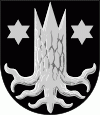Kemijärvi
 |
The first permanent settler inhabitant of Kemijärvi was Paavali Ollinpoika Halonen, who moved from the region of Oulu, from Niskakylä, Utajärvi to Kemijärvi about 1580. His wife was Anna Laurintytär Halonen, and their children were Paavo, Olli and Pekka Halonen. Paavali's place of residence is known today as Halosenranta. As the first settlers moved to Kemijärvi, the area was no longer inhabited exclusively by the Sami people, but Ämmänvaara in the area of the municipality is an ancient sacrificial place of Samis.
The railway reached Kemijärvi in 1934. It was extended north to Salla and what is now Russia during World War II, though the line is currently moribund beyond Kemijärvi. Kemijärvi railway station has passenger train service to Rovaniemi, Oulu and Helsinki. The direct overnight train service between Kemijärvi and Helsinki was controversially withdrawn in September 2006, with VR (Finnish Railways) stating that its new sleeping car trains could not operate with the diesel locomotives needed for the (then) non-electrified railway north of Rovaniemi.
However, a year later, the Ministry of Transport and Communications and VR reached an agreement concerning partial public funding of the service, which was restored in 2008 with a diesel generator car supplying head-end power to the passenger cars. The generator car disappeared from the train in March 2014 when the electrification extension from Rovaniemi to Kemijärvi was inaugurated, an event which also assured Kemijärvi a permanent place in the VR network.
On 9 May 1986, a BAE Hawk Mk 51 crashed in Kemijärvi whilst practising for a flight display due to loss of orientation. The pilot, First Lieutenant M. Kähkönen, died upon impact.
Map - Kemijärvi
Map
Country - Finland
 |
 |
| Flag of Finland | |
Finland was first inhabited around 9000 BC after the Last Glacial Period. The Stone Age introduced several different ceramic styles and cultures. The Bronze Age and Iron Age were characterized by contacts with other cultures in Fennoscandia and the Baltic region. From the late 13th century, Finland became a part of Sweden as a consequence of the Northern Crusades. In 1809, as a result of the Finnish War, Finland became part of the Russian Empire as the autonomous Grand Duchy of Finland, during which Finnish art flourished and the idea of independence began to take hold. In 1906, Finland became the first European state to grant universal suffrage, and the first in the world to give all adult citizens the right to run for public office. After the 1917 Russian Revolution, Finland declared independence from Russia. In 1918, the fledgling state was divided by the Finnish Civil War. During World War II, Finland fought the Soviet Union in the Winter War and the Continuation War, and Nazi Germany in the Lapland War. It subsequently lost parts of its territory, but maintained its independence.
Currency / Language
| ISO | Currency | Symbol | Significant figures |
|---|---|---|---|
| EUR | Euro | € | 2 |
| ISO | Language |
|---|---|
| FI | Finnish language |
| SV | Swedish language |
















